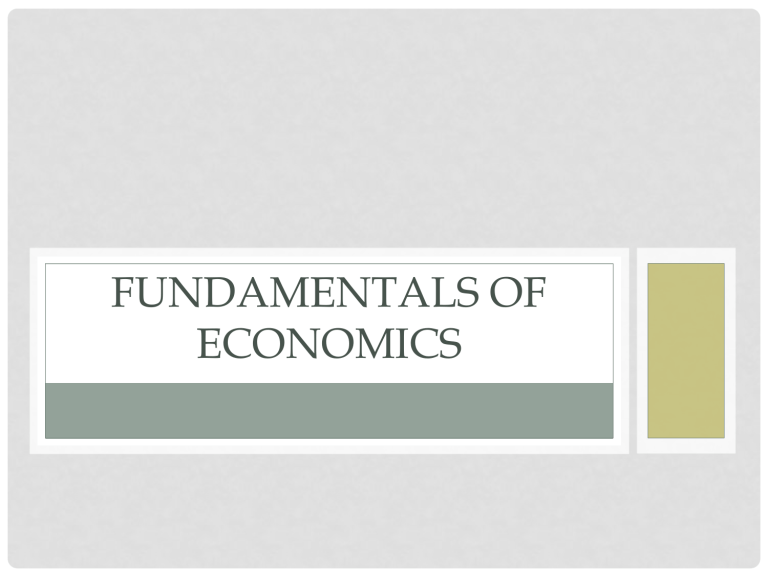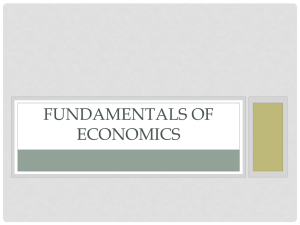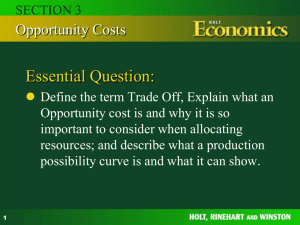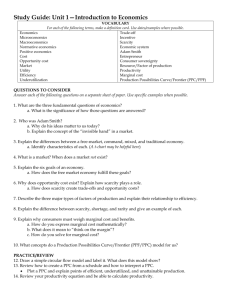Fundamentals of economics

FUNDAMENTALS OF
ECONOMICS
(TOPIC 1)LEARNING OBJECTIVES
• Explain why scarcity & choice are the basis of economics in every society
• Describe the 3 economic factors of production
• Identify why every decision involves trade-offs
• Explain the concept of opportunity cost
• Describe how people make decisions by thinking at the margin
•
Economics:
The study how people seek to satisfy their needs & wants by making choices.
SCARCITY
SCARCITY MEANS MAKING CHOICES
• Unlimited wants, limited resources
• Scarcity does NOT mean shortage https://www.pearsonrealize.com/com munity/program/d23f696c-58d8-3512b201-60055f184497/10/tier/1f587f5fd37a-3c9e-9674-
299bea7942fa/1/lesson/2c43e957-2f01-
3db7-b65e-
170c210b17e4/1/content/b7e415a4e020-3f89-971f-d766e57f044a/1
• Entrepreneurs: people who decided how to combine resources to create new goods & services
• Factors of
Production
Land Labor Capital
Physical Human
TRADE-OFF
• Act of giving up one benefit in order to gain another, greater benefit
• Football or school play?
• Part time job or volunteer work?
• Vacation or new car?
• College or job?
• Grow broccoli or squash?
• Make chairs or tables?
• New roads or education?
GUNS OR BUTTER
•
Governments face trade-offs
•
Guns (military goods)
•
Butter
(consumer goods)
1.2 OPPORTUNITY COST & TRADE-OFFS
• In most trade-off situations, one of the rejected alternatives is more desirable than the rest. The most desirable alternative somebody gives up as the result of a decisions is the opportunity cos.
OPPORTUNITY
COST
• The most desirable alternative somebody gives up as the result of a decision
OPPORTUNITY COST
• Go to bed early or stay up studying
• Go to bed early or go to a party
• Go to bed early or stay up watching Netflix
Your opportunity cost is…
• m
CHECK POINT
• Someone gives up going to see a movie to study for a test in order to get a good grade.
The opportunity cost is ____________
• Jill decides to drive to work instead of taking the bus. It takes her 90 minutes to get there and the bus ride would have been 40, so her opportunity cost is ________
• David decides to quit working and go to school to get further training. The opportunity cost is __________
THINKING AT THE MARGIN
• When making decisions, economists look at opportunity cost & thinking at the margin.
Deciding how much more or less to do
Marginal = Additional
When you add one more additional unit, how much benefit will you get?
MARGINAL COST/MARGINAL BENEFIT
• To make a sensible decision, weigh the marginal cost v the marginal benefit
Extra cost of adding one additional unit
Extra benefit of adding the same unit
• If MB is > MC, then go for it
Look at the marginal cost of each extra hour of studying & compare it to the marginal benefit.
Make your own Decision Making at the
Margin chart
(1.3) PRODUCTION POSSIBILITIES
CURVES
• Objectives:
• Interpret a PPC
• Explain how PPC show efficiency, growth, & opportunity cost
• Explain why a country’s production possibilities depend on its resources & technology
A farmer needs to decide what to grow
& how much.
• In economics you need to decide how to use resources most efficiently
PRODUCTION POSSIBILITIES CURVE
PRODUCTION POSSIBILITIES CURVE
To decide what and how much to produce, economists use a PPC
Any spot on the line represents an economy working at its most efficient level
The line, Production Possibilities Frontier, shows the different combinations possible
Any spot on the line represents an economy working at its most efficient level
The line, Production Possibilities Frontier, shows the different combinations possible
Any spot on the line represents an economy working at its most efficient level
Underutilization: the use of fewer resources than the economy is capable of using
OPPORTUNITY COST
OPPORTUNITY COST
A-B: 20
B-C: 60
C-D: 100
D
Law of Increasing
Opportunity Costs:
Trade-offs get more & more expensive
GROWTH
• A PPC is a snapshot
• In the real world, resources are constantly changing
• If quantity or quality of land, labor, or capital changes, the curve will move
GROWTH
• A PPC is a snapshot
• In the real world, resources are constantly changing
• If quantity or quality of land, labor, or capital changes, the curve will move
Growth examples: more immigration , new natural resources found, better technology
Curve shifts left when production capacity decreases.
Curve shifts left when production capacity decreases.
Decrease in supplies, loss of land during war, natural disaster
GROWTH
• If there is an increase in resources available for one product, then the
PPF may shift at just one end.







